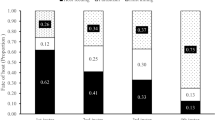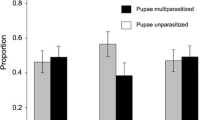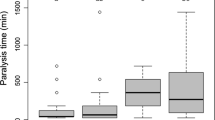Abstract
An appraisal of the regulatory role of natural enemies on target pests requires the identification of the mechanisms/traits that enhance the ability of an organism to control the density of its prey/host. After stinging herbivore hosts with their ovipositor, hymenopteran parasitoids tend to reject them without ovipositing or host-feeding. Termed pseudoparasitism, the frequency and consequences of this type of attack (hereafter oversting) have been largely disregarded in the hymenopteran parasitoid literature. We choose the parasitoids Aphytis melinus and A. chrysomphali and their common host Aonidiella aurantii as a model system to study this behavior. Using field and laboratory observations, we showed that overstinging is a common behavior in the wild. Under controlled conditions, overstinging occurred more frequently than host-feeding, a behavioral trait that is used to evaluate the potential of parasitoids as biological control agents. Oversting reduced the fecundity and survival of the herbivore host. When we compared between parasitoid species that attack the same host species, the virulence and frequency of this behavior depended on parasitoid species. These results demonstrate that overstinging should be incorporated in the models of host–parasitoid interactions to analyze population dynamics as well as in the future selection of parasitoids for biological control.







Similar content being viewed by others
References
Abdelrahman I (1974) Growth, development and innate capacity for increase in Aphytis chrysomphali Mercet and A. melinus DeBach, parasites de California red scale, Aonidiella aurantii (Mask.), in relation to temperature. Aust J Zool 22:213–230
Abram PK, Brodeur J, Burte V, Boivin G (2016) Parasitoid-induced host egg abortion: an underappreciated component of biological control services provided by egg parasitoids. Biol Control 98:52–60
Asgari S, Rivers DB (2011) Venom proteins from endoparasitoid wasps and their role in host-parasite interactions. Annu Rev Entomol 56:313–335
Barratt BI, Johnstone PD (2001) Factors affecting parasitism by Microctonus aethiopoides (Hymenoptera: Braconidae) and parasitoid development in natural and novel host species. Bull Entomol Res 91:245–253
Barrett B, Brunner J (1990) Types of parasitoid-induced mortality, host stage preferences, and sex ratios exhibited by Pnigalio flavipes (Hymenoptera: Eulophidae) using Phyllonorycter elmaella (Lepidoptera: Gracillaridae) as a host. Environ Entomol 19:803–807
Baudoin M (1975) Host castration as a parasitic strategy. Evolution 29:335–352
Beard R (1940) Parasitic castration of Anasa tristis DeG. by Trichopoda pennipes Fab., and its effect on reproduction. J Econ Entomol 33:269–272
Beckage NE (2008) Parasitoid polydnaviruses and insect immunity. In: Beckage NE (ed) Insect immunology. Academic Press/Elsevier, San Diego, pp 243–270
Beckage NE, Gelman DB (2004) Wasp parasitoid disruption of host development: implications for new biologically based strategies for insect control. Annu Rev Immunol 21:759–806
Boyero J, Vela J, Wong E, Garcia-Ripoll C, Verdú MJ, Urbaneja A, Vanaclocha P (2014) Displacement of Aphytis chrysomphali by Aphytis melinus, parasitoids of the California red scale, in the Iberian Peninsula. Span JAgric Res 12:244–251
Brown JJ, Kainoh Y (1992) Host castration by Ascogaster sp. (Hymenoptera: Braconidae). Ann Entomol Soc Am 85:67–71
Casas J, Swarbrick S, Murdoch WW (2004) Parasitoid behaviour: predicting field from laboratory. Ecol Entomol 29:657–665
Cebolla R, Bru P, Urbaneja A, Tena A (2017) Does host quality dictate the outcome of interference competition between sympatric parasitoids? Effects on their coexistence. Anim Behav 127:75–81
Crawley MJ (2007) The R book. Wiley, New York
DeBach P, Sisojevic P (1960) Some effects of temperature and competition on the distribution and relative abundance of Aphytis lingnanensis and A. chrysomphali (Hymenoptera: Aphelinidae). Ecology 41:153–160
Digilio MC, Isidoro N, Tremblay E, Pennacchio F (2000) Host castration by Aphidius ervi venom proteins. J Insect Physiol 46:1041–1050
Godfray HCJ (1994) Parasitoids Behavioral and evolutionary ecology. Princeton University Press, Princeton
Gottlieb Y, Zchori-Fein E, Faktor O, Rosen D (1998) Phylogenetic analysis of parthenogenesis-inducing Wolbachia in the genus Aphytis (Hymenoptera: Aphelinidae). Insect Mol Biol 7:393–396
Heimpel GE, Collier TR (1996) The evolution of host-feeding behaviour in insect parasitoids. Biol Rev 71:373–400
Heimpel G, Rosenheim J, Mangel M (1998) Effects of time limitation and egg limitation on lifetime reproductive success of a parasitoid in the field. Am Nat 152:273–289
Hopper KR, Prager SM, Heimpel GE (2013) Is parasitoid acceptance of different host species dynamic? Funct Ecol 27:1201–1211
Jervis MA (2005) Insects as natural enemies: a practical perspective. Springer, New York
Johnson D, Akre BG, Crowley PH (1975) Modeling arthropod predation: wasteful killing by damselfly naiads. Ecology 56:1081–1093
Jones D (1985) Parasite regulation of host insect metamorphosis: a new form of regulation in pseudoparasitized larvae of Trichoplusia ni. J Comp Physiol 155:583–590
Jones D, Jones G, Rudnicka M, Click A, Malleczewen VR, Iwaya M (1986) Pseudoparasitism of host Trichoplusia ni by Chelonus spp. as a new model system for parasite regulation of host physiology. J Insect Physiol 32:315–328
Keinan Y, Kishinevsky M, Segoli M, Keasar T (2012) Repeated probing of hosts: an important component of superparasitism. Behav Ecol 23:1263–1268
Mills NJ, Wajnberg É (2008) Optimal foraging behavior and efficient biological control methods. In: Wajnberg E, Bernstein C, van Alphen JJM (eds) Behavioral ecology of insect parasitoids: from theoretical approaches to field applications. Blackwell Science, Oxford, pp 3–30
Monzó C, Molla Ó, Castañera P, Urbaneja A (2009) Activity-density of Pardosa cribata in Spanish citrus orchards and its predatory capacity on Ceratitis capitata and Myzus persicae. Biocontrol 54:393–402
Münster-Swendsen M (1994) Pseudoparasitism: detection and ecological significance in Epinotia tedella (Cl.) (Tortricidae). Nor J Agric Sci Suppl 16:329–335
Münster-Swendsen M (2002) Population cycles of the spruce needle-miner in Denmark driven by interactions with insect parasitoids. In: Berryman A (ed) Population cycles. The case for trophic interactions. Oxford University Press, Oxford, pp 29–43
Münster-Swendsen M, Berryman A (2005) Detecting the causes of population cycles by analysis of R-functions: the spruce needle-miner, Epinotia tedella, and its parasitoids in Danish spruce plantations. Oikos 108:495–502
Murdoch WW, Luck RF, Swarbrick SL, Walde S, Yu DS (1995) Regulation of an insect population under biological control. Ecology 76:206–217
Murdoch WW, Briggs CJ, Nisbet RM (1996) Competitive displacement and biological control in parasitoids: a model. Am Nat 184:807–826
Murdoch WW, Briggs CJ, Nisbet RM (1997) Dynamical effects of host-size and parasitoid state-dependent attacks by parasitoids. J Anim Ecol 66:542–556
Murdoch WW, Briggs CJ, Swarbrick SL (2005) Host suppression and stability in a parasitoid-host system: experimental demonstration. Science 309:610–613
Neuenschwander P, Schulthess F, Madojemu E (1986) Experimental evaluation of the efficiency of Epidinocarsis lopezi, a parasitoid introduced into Africa against the cassava mealybug Phenacoccus manihoti. Entomol Exp App 42:133–138
Pekár S (2005) Predatory characteristics of ant-eating Zodarion spiders (Araneae: Zodariidae): potential biological control agents. Biol Control 34:196–203
Pekas A, Aguilar A, Tena A, Garcia-Marí F (2010) Influence of host size on parasitism by Aphytis chrysomphali and A. melinus (Hymenoptera: Aphelinidae) in Mediterranean populations of California red scale Aonidiella aurantii (Hemiptera: Diaspididae). Biol Control 55:132–140
Pekas A, Tena A, Harvey JA, Garcia-Marí F, Frago E (2016) Host size and spatiotemporal patterns mediate the coexistence of specialist parasitoids. Ecology 37:1345–1356
Pérez-Hedo M, Urbaneja A (2015) Prospects for predatory mirid bugs as biocontrol agents of aphids in sweet peppers. J Pest Sci 88:65–73
Pina T (2007) Control biológico del piojo rojo de California, Aonidiella aurantii (Maskell) (Hemiptera: Diaspididae) y estrategias reproductivas de su principal enemigo natural Aphytis chrysompahli (Mercet) (Hymenoptera: Aphelinidae). Dissertation, Universidad de Valencia, Valencia
Rasband WS (2016). ImageJ. Bethesda, MD: U.S. National Institutes of Health. http://imagej.nih.gov/ij
Reed-larsen DA, Brown JJ (1990) Embryonic castration of the codling moth Cydia pomonella by an endoparasitoid, Ascogaster quadridentata. J Insect Physiol 36:111–118
Rosen D, DeBach P (1979) Species of Aphytis of the world (Hym.: Aphelinidae). Israel Universities Press, Jerusalem
Salt G (1968) The resistance of insect parasitoids to the defence reactions of their hosts. Biol Rev 43:200–232
Schlaepfer MA, Sherman PW, Blossey B, Runge MC (2005) Introduced species as evolutionary traps. Ecol Lett 8:241–246
Schlinger EI, Hall JC (1960) The biology, behaviour, and morphology of Praon palitans Muesebek, an internal parasite of the spotted alfalfa aphid, Therioaphis maculata (Buckton) (Hymenoptera: Braconidae, Aphidiinae). Ann Entomol Soc Am 53:144–160
Shea K, Nisbet RM, MurdochWW Yoo HJS (1996) The effect of egg limitation on stability in insect host-parasitoid population models. J Anim Ecol 65:743–755
Sorribas J, Rodríguez R, Garcia-Marí F (2010) Parasitoid competitive displacement and coexistence in citrus agroecosystems: linking species distribution with climate. Ecol Appl 20:1101–1113
Spencer H (1926) Biology of the parasites and hyperparasites of aphids. Ann Entomol Soc Am 19:119–157
Strand MR (1986) The physiological interactions of parasitoids with their hosts and their influence on reproductive strategies. Insect parasitoids. Academic Press, London, pp 97–136
Tagashira E, Tanaka T (1998) Parasitic castration of Pseudaletia separata by Cotesia kariyai and its association with polydnavirus gene expression. J Insect Physiol 44:733–744
Tena A, Pekas A, Wäckers FL, Urbaneja A (2013) Energy reserves of parasitoids depend on honeydew from non-hosts. Ecol Entomol 38:278–289
van Driesche RG, Bellotti A, Herrera CJ, Castello JA (1987) Host feeding and ovipositor insertion as sources of mortality in the mealybug Phenacoccus herreni caused by two encyrtids, Epidinocarsis diversicornis and Acerophagus coccois. Entomol Exp Appl 44:97–100
Vanaclocha P (2012) Gestión integrada del piojo rojo de California, Aonidiella aurantii (Maskell) (Hemiptera: Diaspididae): Mejora de su control biológico. Dissertation, Universitat Jaume I, Castellón
Vinson SB (1976) Host selection by insect parasitoids. Annu Rev Entomol 21:109–133
Acknowledgements
We acknowledge Jérôme Casas and an anonymous reviewer for valuable comments. The research has received funding from the Spanish Ministry of Science and Innovation (AGL2011-30538-C03) and the Conselleria d’Agricultura, Pesca i Alimentació de la Generalitat Valenciana. The authors thank R. Romero and C. Ramos for their help with the statistical analyses and P. Bru (IVIA) for technical assistance with the experiments. R.C. was supported by a FPI scholarship from the Spanish Ministry of Science and Innovation (MICINN).
Author information
Authors and Affiliations
Corresponding author
Ethics declarations
Conflict of interest
The authors declare that they have no conflict of interest.
Additional information
Communicated by V. Gagic.
Annex
Annex

Rights and permissions
About this article
Cite this article
Cebolla, R., Vanaclocha, P., Urbaneja, A. et al. Overstinging by hymenopteran parasitoids causes mutilation and surplus killing of hosts. J Pest Sci 91, 327–339 (2018). https://doi.org/10.1007/s10340-017-0901-9
Received:
Revised:
Accepted:
Published:
Issue Date:
DOI: https://doi.org/10.1007/s10340-017-0901-9




